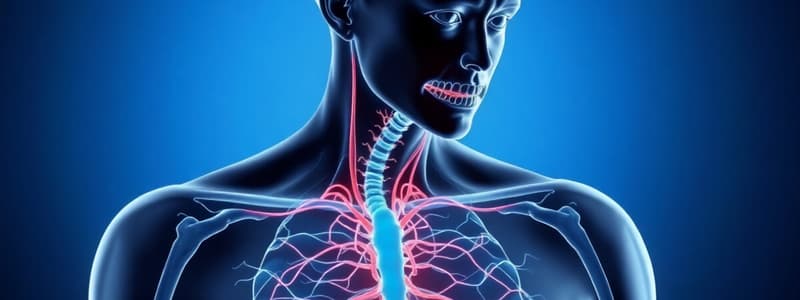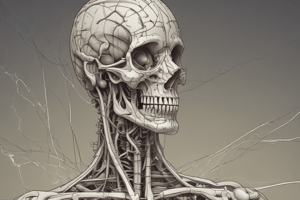Podcast
Questions and Answers
Which generalization concerning the autonomic nervous system is not true?
Which generalization concerning the autonomic nervous system is not true?
- It regulates visceral activities.
- All of its neurons are motor.
- It operates without conscious control.
- All of its axons are afferent fibers. (correct)
Which of the following would not be a major effector of the autonomic nervous system?
Which of the following would not be a major effector of the autonomic nervous system?
- Skeletal muscles (correct)
- Iris of the eye
- Sweat glands
- Blood vessels
Somatic motor and autonomic pathways share all of the following characteristics except:
Somatic motor and autonomic pathways share all of the following characteristics except:
- acetylcholine.
- location of peripheral fibers.
- direction of information flow.
- number of neurons between the CNS and effector. (correct)
The autonomic nervous system functions chiefly in the:
The autonomic nervous system functions chiefly in the:
Once inside the sympathetic chain ganglion, the preganglionic fiber may:
Once inside the sympathetic chain ganglion, the preganglionic fiber may:
Sympathetic responses generally have widespread effects on the body because:
Sympathetic responses generally have widespread effects on the body because:
Parasympathetic neuron cell bodies are located in:
Parasympathetic neuron cell bodies are located in:
Which of the following is not an example of sympathetic stimulation?
Which of the following is not an example of sympathetic stimulation?
All of the following are examples of parasympathetic stimulation except:
All of the following are examples of parasympathetic stimulation except:
“Fight-or-flight” physiological changes include all of the following except:
“Fight-or-flight” physiological changes include all of the following except:
All of the following are characteristics of sympathetic preganglionic neurons except:
All of the following are characteristics of sympathetic preganglionic neurons except:
Norepinephrine is liberated at:
Norepinephrine is liberated at:
Beta receptors:
Beta receptors:
Propranolol is an example of a:
Propranolol is an example of a:
A child was frightened by a large dog. The pupils of the child’s eyes became dilated, and the heart and respiratory rates increased. These symptoms were caused by stimulation of:
A child was frightened by a large dog. The pupils of the child’s eyes became dilated, and the heart and respiratory rates increased. These symptoms were caused by stimulation of:
Which of the following might occur from the stimulation of parasympathetic fibers?
Which of the following might occur from the stimulation of parasympathetic fibers?
Parasympathetic stimulation has no effect on any of the following areas except:
Parasympathetic stimulation has no effect on any of the following areas except:
Which of the following statements is not true?
Which of the following statements is not true?
Alpha receptors bind with:
Alpha receptors bind with:
Which is not true about sympathetic postganglionic neurons?
Which is not true about sympathetic postganglionic neurons?
Which is not true about parasympathetic postganglionic neurons?
Which is not true about parasympathetic postganglionic neurons?
Acetylcholine can stimulate _____ receptors.
Acetylcholine can stimulate _____ receptors.
Norepinephrine can stimulate _____ receptors.
Norepinephrine can stimulate _____ receptors.
Both sympathetic and parasympathetic divisions are tonically active, which means they:
Both sympathetic and parasympathetic divisions are tonically active, which means they:
How does a dually innervated autonomic effector differ from a singly innervated autonomic effector?
How does a dually innervated autonomic effector differ from a singly innervated autonomic effector?
Which of the following is a description of the principle of autonomic antagonism as it relates to the autonomic nervous system?
Which of the following is a description of the principle of autonomic antagonism as it relates to the autonomic nervous system?
If you were to damage some of the preganglionic fibers that enter the celiac ganglion, what effect would this have on sympathetic stimulation?
If you were to damage some of the preganglionic fibers that enter the celiac ganglion, what effect would this have on sympathetic stimulation?
Flashcards
Autonomic Nervous System
Autonomic Nervous System
Operates without conscious control and regulates visceral activities via motor neurons.
Similarities
Similarities
Somatic motor and autonomic pathways share the direction of information flow along peripheral fibers, using acetylcholine.
Autonomic Function
Autonomic Function
Coordinates smooth muscle innervation in the viscera.
Preganglionic Fiber Actions
Preganglionic Fiber Actions
Signup and view all the flashcards
Widespread Sympathetic Effects
Widespread Sympathetic Effects
Signup and view all the flashcards
Parasympathetic Neuron Cell Bodies
Parasympathetic Neuron Cell Bodies
Signup and view all the flashcards
Sympathetic Stimulation Examples
Sympathetic Stimulation Examples
Signup and view all the flashcards
NOT Sympathetic Stimulation
NOT Sympathetic Stimulation
Signup and view all the flashcards
Norepinephrine Secretion
Norepinephrine Secretion
Signup and view all the flashcards
Parasympathetic Postganglionic Neurons
Parasympathetic Postganglionic Neurons
Signup and view all the flashcards
Dually Innervated Effector
Dually Innervated Effector
Signup and view all the flashcards
Opposing Impulses
Opposing Impulses
Signup and view all the flashcards
Tonically Active Divisions
Tonically Active Divisions
Signup and view all the flashcards
Study Notes
- The autonomic nervous system regulates visceral activities without conscious control and uses motor neurons.
Autonomic Nervous System Effectors
- Major effectors of the autonomic nervous system include blood vessels, sweat glands, and the iris of the eye, but not skeletal muscles.
Somatic vs. Autonomic Pathways
- Somatic motor and autonomic pathways share direction of information flow and location of peripheral fibers, but not the number of neurons between the CNS and effector, or acetylcholine use.
Autonomic Nervous System Function
- The autonomic nervous system primarily innervates smooth muscle in the viscera.
Sympathetic Chain Ganglion
- Once inside the sympathetic chain ganglion, a preganglionic fiber can synapse with a postganglionic neuron, send branches through the sympathetic trunk to synapse in other ganglia, or pass through ganglia without synapsing.
Sympathetic Responses
- Sympathetic responses have widespread effects due to preganglionic fibers synapsing with several postsynaptic fibers.
Parasympathetic Neuron Location
- Parasympathetic neuron cell bodies are located in the nuclei of the brainstem and the lateral gray columns of the sacral cord.
Sympathetic Stimulation
- Constriction of bronchioles is not an example of sympathetic stimulation, but decreased secretion of the pancreas, constriction of urinary sphincters, and dilation of skeletal muscle blood vessels are.
Parasympathetic Stimulation
- Increased heart rate is not an example of parasympathetic stimulation.
Fight-or-Flight Response
- Constriction of respiratory airways is not part of the "fight-or-flight" response; increased conversion of glycogen to glucose, increased sweating, and dilation of blood vessels in skeletal muscles are.
Sympathetic Preganglionic Neurons
- Sympathetic preganglionic neurons secrete acetylcholine and have dendrites and cell bodies in the lateral gray columns of the thoracic and first four lumbar segments of the spinal cord, but they do not have long fibers from the CNS to the ganglion.
Norepinephrine Release
- Norepinephrine is liberated at most sympathetic postganglionic nerve endings.
Beta Receptors
- Beta receptors bind norepinephrine.
Propranolol
- Propranolol is a beta blocker used to treat irregular heartbeats and hypertension.
Sympathetic Nervous System Stimulation
- Increased heart and respiratory rates and dilated pupils due to the sympathetic nervous system following a stimulus.
Parasympathetic Stimulation
- Increased peristalsis in the digestive tract results from stimulation of parasympathetic fibers.
Parasympathetic Stimulation Effects
- Parasympathetic stimulation does not affect sweat glands, skin blood vessels or the liver, but does affect the urinary bladder.
Parasympathetic Division
- The parasympathetic division is the primary controller of autonomic effectors most of the time, secreting pancreatic juice and insulin, but does not serve as an "emergency" system.
Alpha Receptors
- Alpha receptors bind with norepinephrine.
Sympathetic Postganglionic Neurons
- Sympathetic postganglionic neurons produce norepinephrine and have acetylcholine receptors on their dendrites, however, they do not produce acetylcholine.
Parasympathetic Postganglionic Neurons
- Parasympathetic postganglionic neurons produce acetylcholine and have acetylcholine receptors on their dendrites, and are typically shorter than preganglionic neurons.
Acetylcholine Stimulation
- Acetylcholine can stimulate nicotinic receptors.
Norepinephrine Stimulation
- Norepinephrine can stimulate alpha and beta receptors.
Dually vs. Singly Innervated Effectors
- A dually innervated effector receives input from both sympathetic and parasympathetic pathways, while a singly innervated effector receives input from only one division.
Autonomic Antagonism
- Autonomic antagonism is when sympathetic impulses stimulate an effector, parasympathetic impulses tend to inhibit it, and vice versa.
Tonic Activity
- Sympathetic and parasympathetic divisions are tonically active, continually conducting impulses to autonomic effectors.
Damage to Celiac Ganglion Fibers
- Damage to preganglionic fibers entering the celiac ganglion may prevent hormones secreted by the adrenal medulla from reaching sympathetic effectors, delaying the effects of sympathetic stimulation.
Studying That Suits You
Use AI to generate personalized quizzes and flashcards to suit your learning preferences.



